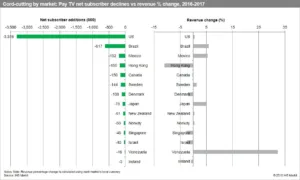The cord-cutting trend that threatens the future of the global pay TV industry was not confined solely to the United States in 2017. Total pay TV subscriptions also declined in 13 other markets — Brazil, Mexico, Hong Kong, Canada, Sweden, Denmark, Japan, New Zealand, Norway, Singapore, Israel, Venezuela and Ireland. Customers cancelling their TV services in favour of online alternatives has been a key factor in declining subscriptions for cable, satellite, IPTV and pay digital-terrestrial TV around the world, according to IHS Markit. Ted Hall, director of research and analysis for TV and video, commented:
“The cord-cutting woes of pay TV companies in the US have been well publicized. Although the rest of the world has been broadly resisting the trend, other markets have also experienced pay TV subscription losses”.
Significantly, only six of the 14 markets affected in 2017 also experienced declines in pay TV revenue. In eight countries — the US, Brazil, Mexico, Sweden, Japan, New Zealand, Norway and Venezuela — operators were able to compensate for customer losses by increasing the amount of revenue generated by their remaining subscriptions. Even in the US, where 3.3 million pay TV subscriptions were lost in 2017, operators were able to collectively increase pay TV revenue by relying on upselling and price increases.
Latin America experienced its first net decline in pay TV subscriptions since 2002 last year, with cord-cutting contributing in part to decreases in two major markets. Brazil lost 617,000 pay TV subscriptions, while Mexico declined by 192,000, as economic difficulties also took their toll. Meanwhile, Venezuela’s pay TV market lost 16,000 subscriptions, as the country’s financial crisis worsened.
With a net loss of 3.5 million subscriptions, North America suffered its biggest-ever annual pay TV decline last year. Between 2012 and 2017, pay TV subscriptions fell by 7.1 million in the region. Meanwhile, net additions for Netflix and other OTT subscription video services totalled 101.3 million over the same period, with more than 26 million OTT subscriptions added in 2017.
The cord-cutting trend has been most strongly associated with cable TV, but satellite TV is also struggling in several regions. It declined more than any other platform in both North America and Latin America in 2017, suffering net losses of 1.8 million and 882,000, respectively. Hall continued:
“As part of their response to cord-cutting, a growing number of pay TV operators are launching their own standalone streaming services to compete directly with offerings from Netflix, Amazon Prime Video and other OTT video companies.
These virtual alternatives to traditional pay TV are more flexible and typically priced lower than operators’ core offerings. However, substituting pay TV subscriptions for OTT is only a partial solution, as these services have lower average revenue per user and are therefore worth less to operators”.
Forecasting the performance of the pay TV market over the next five years, IHS Markit anticipates further cord-cutting in North America, with a net decline of 8.5 million pay TV subscriptions anticipated between the end of 2017 and the end of 2022. Latin America is expected to return to growth, as Brazil continues on the path of economic recovery.
Elsewhere in the world, alongside the growth of pay TV subscriptions in most regions, the surge in online video will continue unabated. Over the five years to the end of 2022, OTT net additions are expected to outstrip those of pay TV everywhere except the Middle East and Africa, where pay TV will grow faster. In total, 409 million OTT video subscriptions will be added globally over the forecast period, with almost two-thirds to come from Asia Pacific.

